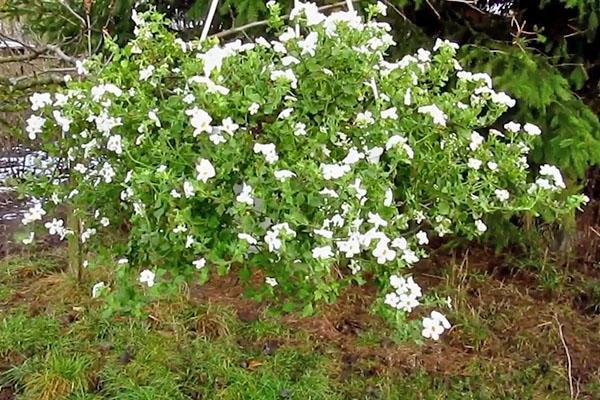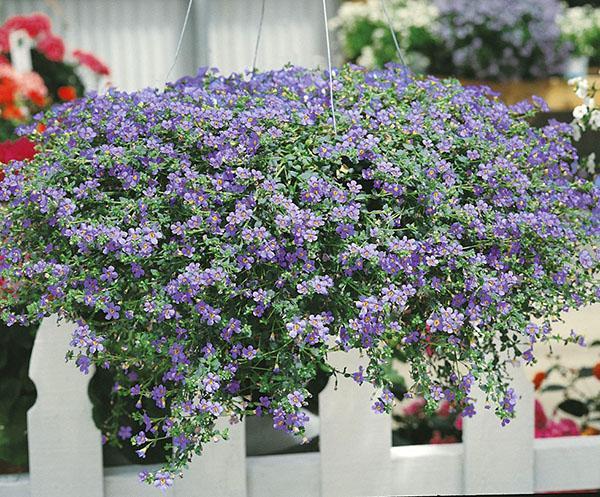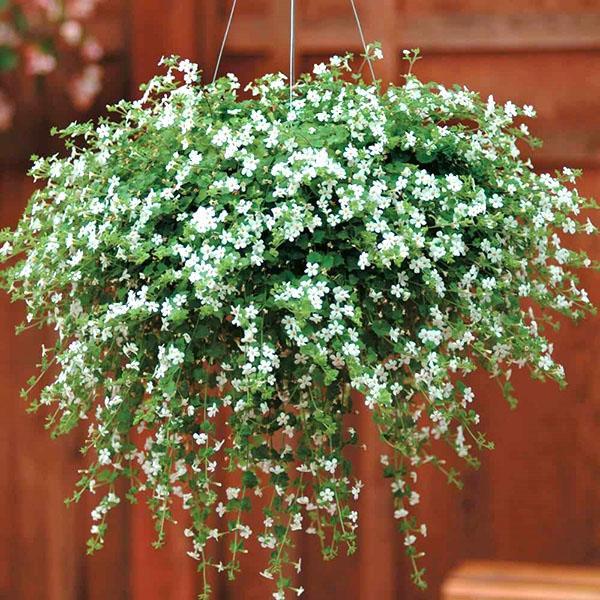Amazing Bacopa that won't be a hassle to plant and maintain
 Bacopa flower, planting and caring for which is not difficult, is quite popular among flower growers and amateurs. If you follow simple recommendations, then the plant will certainly delight you with a beautiful appearance, which will remain until the very frost.
Bacopa flower, planting and caring for which is not difficult, is quite popular among flower growers and amateurs. If you follow simple recommendations, then the plant will certainly delight you with a beautiful appearance, which will remain until the very frost.
Bacopa: plant description, main species

Popular types:
- Bacopa Snowtopia. An excellent combination of unpretentiousness and beauty in one form. When flowering, the bush looks more like a ball. Shoots grow up to 60 cm in length. Prefers places without direct sunlight. Looks great in combination with various flowering plants in hanging flowerpots and baskets.

- Bacopa Snow avalanche. Numerous snow-white buds are a distinctive feature of this variety, and the plant blooms for a very long time. It is more often used in landscape design as an ampelous culture and is grown in pots. It is combined with standard plants.

- Bacopa Monnier or small-leaved. This variety has creeping, creeping shoots. The foliage is small, up to 0.5 cm in length, delicate olive shade, very juicy. If you press it, you immediately feel the lemon scent. Monier blooms with small blue or white flowers, consisting of 4-5 petals.

- Karolinska Bacopa is especially popular. The stem of the plant is long, covered with juicy, rich green leaves, reaching 2-2.5 cm in length. The plates are arranged in pairs. This is an aquarium species that multiplies very quickly. Because of this, he is especially popular.

In artificial body of water Bacopa Karolinska will grow all year round.
Bacopa: planting and caring for a plant
 The plant needs sufficient light, especially in the morning and evening. In the middle of the day, the bush must be shaded from the sweltering heat. Therefore, in order for the plant to feel good, the best places to plant are areas located near tall bushes.
The plant needs sufficient light, especially in the morning and evening. In the middle of the day, the bush must be shaded from the sweltering heat. Therefore, in order for the plant to feel good, the best places to plant are areas located near tall bushes.
Sutera easily tolerates significant temperature fluctuations. Thanks to this, it can be kept outdoors from spring to autumn frosts.
At temperatures below -50 The flower may die.
This is a culture that is very fond of light. The abundance of flowering directly depends on its quantity. In a darkened place, the plant will be comfortable, but the sutera will spend all his strength on the accumulation of stems and foliage. In this case, the branches will be strongly elongated, the buds will decrease.
When choosing a substrate, the most optimal option is a soil with a slightly acidic reaction (about 6.5 pH). Good drainage and a high organic content are important. In open beds, they simply add to the ground peat... But best of all, bacopa grows and blooms precisely when it is kept in a pot, in a mixture of humus, peat and river sand with leafy soil.
Landing rules
 Due to the elongated shoots, the plant is used to create horizontal as well as vertical compositions. If you lift the stems up and fasten them to the lattice, you get a decorative wall.
Due to the elongated shoots, the plant is used to create horizontal as well as vertical compositions. If you lift the stems up and fasten them to the lattice, you get a decorative wall.
Ampelous plants are especially popular. Because of their unusual appearance, they are often planted in hanging flowerpots.Also, ampelous varieties are used in areas where it is necessary to cover hatches or untidy places.
They planted it outside only after frost. The distance between individual specimens depends on the size of the future bush and its variety, but not less than 10-15 cm. A drainage layer must be poured onto the bottom of the hole, covered with soil and a plant is planted. The space is covered with earth, tamped and watered abundantly.
Plant care
 The plant is not capricious, but for abundant flowering you need to follow simple rules of care.
The plant is not capricious, but for abundant flowering you need to follow simple rules of care.
Watering the plant
 This is one of the most important factors to watch out for when growing Bacopa. After planting, if the weather is quite hot, the flower is watered twice a day. In this case, water should not fall on the deciduous plates, otherwise they will get burned.
This is one of the most important factors to watch out for when growing Bacopa. After planting, if the weather is quite hot, the flower is watered twice a day. In this case, water should not fall on the deciduous plates, otherwise they will get burned.
In order for the flower to winter well, in the cold months the flowerpot must be placed in a dark place, and watering must be reduced to 1 time in two weeks.
Spraying is very good. It is recommended to do this early in the morning and in the evening, after sunset. As soon as buds begin to form on the plant, the procedure is stopped.
Fertilizing and feeding
 With an active growing season from spring to autumn, the flower is fertilized every week, alternating mineral mixtures and organic fertilizers. In order for a flower to be strong, with bright foliage and bloom well, it requires, in addition to the typical elements of potassium and phosphorus, also compounds of magnesium and manganese.
With an active growing season from spring to autumn, the flower is fertilized every week, alternating mineral mixtures and organic fertilizers. In order for a flower to be strong, with bright foliage and bloom well, it requires, in addition to the typical elements of potassium and phosphorus, also compounds of magnesium and manganese.
Pruning Bacopa
 Without proper pruning, the bush loses its attractiveness and decorative effect. Immediately after rooting, the plant begins to pinch at the growth points of the lateral and main shoots. As the bush grows, crown formation continues. The flower is also cut off when the shoots are greatly elongated. They should not exceed 65 cm.
Without proper pruning, the bush loses its attractiveness and decorative effect. Immediately after rooting, the plant begins to pinch at the growth points of the lateral and main shoots. As the bush grows, crown formation continues. The flower is also cut off when the shoots are greatly elongated. They should not exceed 65 cm.
Plant pick
When growing, suters must dive it. The first time is when transplanting seedlings into separate pots, when three leaves appear on the sprouts. You can also grow them in a common box, ensuring the distance between adjacent specimens is 2 cm. The second time they dive during the period when the flower is transplanted to its permanent place (pots, open beds).
Bacopa wintering
 On the street, the flower will not tolerate severe frosts, therefore, it is taken to a warm room for wintering. If you bring it in before the first frost and provide suitable conditions, then the plant will continue to bloom and will delight everyone with its appearance until the New Year.
On the street, the flower will not tolerate severe frosts, therefore, it is taken to a warm room for wintering. If you bring it in before the first frost and provide suitable conditions, then the plant will continue to bloom and will delight everyone with its appearance until the New Year.
After the bacopa has faded, it should be pruned and moved to a well-lit but cool room with a temperature of + 10 ° - + 150 C. A glazed balcony is an excellent option. At the same time, the soil should not dry out, but watering is significantly reduced. If necessary, spray the plant periodically.
Reproduction methods

The flower is propagated using seeds or cuttings. The simplest is the second way:
- The planting option is separated at the end of autumn during pruning of excessively elongated shoots or with the onset of spring.
- It is enough to bury the cuttings in well-moistened loose soil or sand.
- Rooted twigs are planted in the beds at the very end of spring, when the frost has already passed.
 Seeds are sown in the second half of winter when the day is longer. They are not buried, but simply laid out over the surface of loose soil and slightly pressed. In order for the seeds to germinate, the temperature should be maintained at least +180 C, providing high humidity. The best option is to keep the bacopa seeds in a greenhouse until the first shoots appear. This happens 10-12 days after sowing.
Seeds are sown in the second half of winter when the day is longer. They are not buried, but simply laid out over the surface of loose soil and slightly pressed. In order for the seeds to germinate, the temperature should be maintained at least +180 C, providing high humidity. The best option is to keep the bacopa seeds in a greenhouse until the first shoots appear. This happens 10-12 days after sowing.
An unusual and new plant in our latitudes, Bacopa is not at all a capricious and very beautiful flower. Its use in medicine is still only being studied, but flower growers have already appreciated the high decorative properties of the plant.